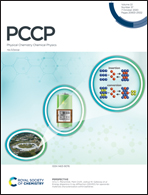Distance measurements between carbon and bromine using a split-pulse PM-RESPDOR solid-state NMR experiment†
Abstract
Solid-state nuclear magnetic resonance has long been used to probe atomic distances between nearby nuclear spins by virtue of the dipolar interaction. New technological advances have recently enabled simultaneous tuning of the radio-frequency resonance circuits to nuclei with close Larmor frequencies, bringing great promise, among other experiments, also to distance measurements between such nuclei, in particular for nuclei with a spin larger than one-half. However, this new possibility has also required modifications of those experiments since the two nuclei cannot be irradiated simultaneously. When measuring distances between a spin S = 1/2 and a quadrupolar spin (S > ½), this drawback can be overcome by splitting the continuous-wave recoupling pulse applied to the quadrupolar nucleus. We show here that a similar adjustment to a highly-efficient phase-modulated (PM) recoupling pulse enables distance measurements between nuclei with close Larmor frequencies, where the coupled spin experiences a very large coupling. Such an experiment, split phase-modulated RESPDOR, is demonstrated on a 13C–81Br system, where the difference in Larmor frequencies is only 7%, or 11.2 MHz on a 14.1 T magnet. The inter-nuclear distances are extracted using an unscaled analytical formula. Since bromine usually experiences particularly high quadrupolar couplings, as in the current case, we suggest that the split-PM-RESPDOR experiment can be highly beneficial for research on bromo-compounds, including many pharmaceuticals, where carbon–bromine bonds are prevalent, and organo-catalysts utilizing the high reactivity of bromides. We show that for butyl triphenylphosphonium bromide, the solid-state NMR distances are in agreement with a low-hydration compound rather than a water-caged semi-clathrate form. The split-PM-RESPDOR experiment is suitable for distance measurements between any quadrupolar ↔ spin-1/2 pair, in particular when the quadrupolar spin experiences a significantly large coupling.



 Please wait while we load your content...
Please wait while we load your content...